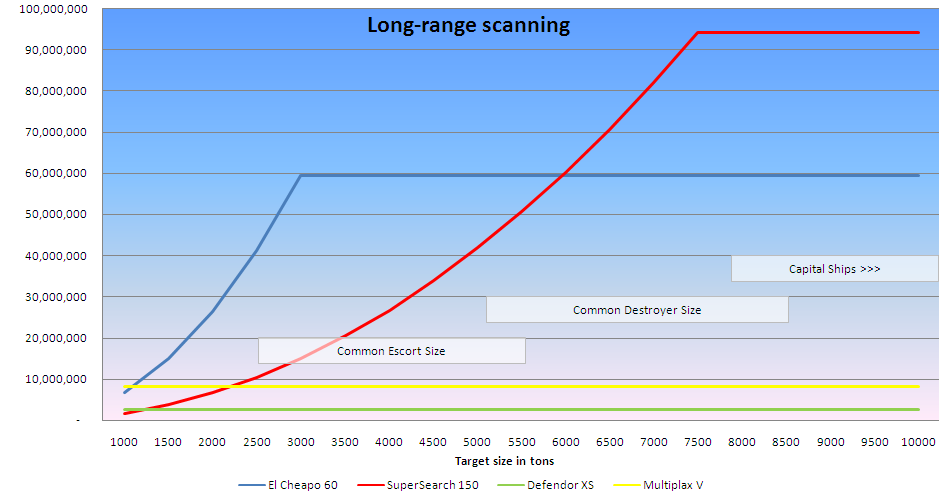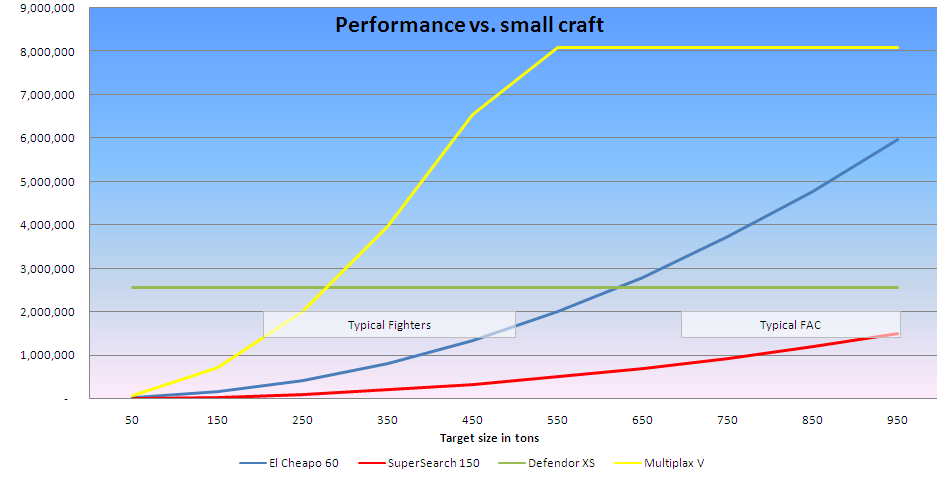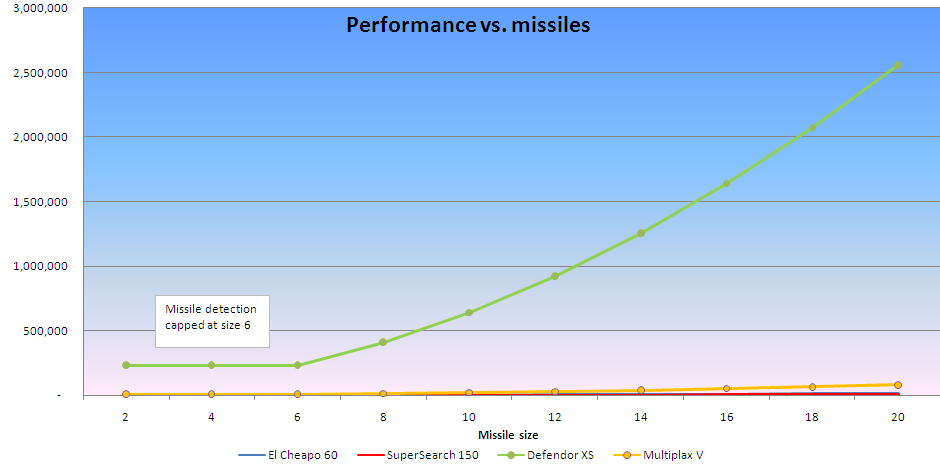Aurora is on version 2.5.0 C#, available at the Aurora Forums.
Contact Erik on the forum for a wiki account.
Difference between revisions of "Active Sensor Design"
(Created page with "Let's have a look at Active Sensors. Why would you want more than one type? Bigger is better, right? Let's see. The rules say that: The Range of an active sensor is equal to:...") |
|||
| Line 11: | Line 11: | ||
Now I've designed four different sensors for different roles (I'm not saying that they are optimal for the job): | Now I've designed four different sensors for different roles (I'm not saying that they are optimal for the job): | ||
| − | * The ElCheapo 60 is a 300-ton (size 6) search apparatus with a resolution of 60, equal to a 3,000-tons ship. I want to stick it onto everything that flies and needs a pair of eyes. | + | * The '''ElCheapo 60''' is a 300-ton (size 6) search apparatus with a resolution of 60, equal to a 3,000-tons ship. I want to stick it onto everything that flies and needs a pair of eyes. |
| − | * The SuperSearch 150 weighs the same, but is intended to spot bigger fish at longer range. Therefore it gets a resolution of 150 (7500 tons). | + | * The '''SuperSearch 150''' weighs the same, but is intended to spot bigger fish at longer range. Therefore it gets a resolution of 150 (7500 tons). |
| − | * The Defendor XS is going to be my standard short-range sensor. Size 2 means it weighs only 100 tons, so I can | + | * The '''Defendor XS''' is going to be my standard short-range sensor. Size 2 means it weighs only 100 tons, so I can |
| − | * Finally, the R&D department is trying to sell me the idea of a small (100 tons again) low-res (10, equals 500 tons) sensor - the Multiplax V. Let's see what it can do. | + | * Finally, the R&D department is trying to sell me the idea of a small (100 tons again) low-res (10, equals 500 tons) sensor - the '''Multiplax V'''. Let's see what it can do. |
ElCheapo 60 SuperSearch 150 Defendor XS Multiplax V | ElCheapo 60 SuperSearch 150 Defendor XS Multiplax V | ||
| Line 21: | Line 21: | ||
Sensor Size 6 6 2 2 | Sensor Size 6 6 2 2 | ||
EM Sensitivity 8 8 8 8 | EM Sensitivity 8 8 8 8 | ||
| − | Max Range | + | Max Range in km 59,489,024 94,060,406 2,560,000 8,095,431 |
| Line 31: | Line 31: | ||
Fine. Three months later the technicians come back with lots of diagrams. What does it all mean? | Fine. Three months later the technicians come back with lots of diagrams. What does it all mean? | ||
| − | At long range, the Defendor and the Multiplax don't even play. No surprise here. And the SuperSearch clearly out-ranges the ElCheapo. It can spot a 10,000-ton battleship at almost 100 million km. And that's its maximum range against all targets bigger than that, too. Obviously the best of the lot! | + | At long range, the Defendor and the Multiplax don't even play. No surprise here. And the '''SuperSearch''' clearly out-ranges the '''ElCheapo'''. It can spot a 10,000-ton battleship at almost 100 million km. And that's its maximum range against all targets bigger than that, too. Obviously the best of the lot! |
| − | But wait: the SuperSearch sees big things at long range, but the smaller the target ship, the more myopic the SuperSearch becomes. To the degree that a lousy 2,500-ton missile frigate could sneak up to us and fire missiles from a mere 10 million km away and all without a single blip on the screen! | + | But wait: the '''SuperSearch''' sees big things at long range, but the smaller the target ship, the more myopic the SuperSearch becomes. To the degree that a lousy 2,500-ton missile frigate could sneak up to us and fire missiles from a mere 10 million km away and all without a single blip on the screen! |
| − | The ElCheapo with its lower resolution would spot the same attacker at about 45 million km, hopefully giving us more than enough time to react. | + | The '''ElCheapo''' with its lower resolution would spot the same attacker at about 45 million km, hopefully giving us more than enough time to react. |
| Line 42: | Line 42: | ||
Next test: what if our tentacled friends launched a bunch of fast [[Fighters]] or [[Fast Attack Craft]]? Let's say the fighters weigh 450 tons (size 9) and the FAC weigh 950 tons. | Next test: what if our tentacled friends launched a bunch of fast [[Fighters]] or [[Fast Attack Craft]]? Let's say the fighters weigh 450 tons (size 9) and the FAC weigh 950 tons. | ||
| − | Ouch. The SuperSearch probably wouldn't notice them before they rammed the main antenna. The ElCheapo does better, but a whole squadron of really small fighters could still get very close (< 1 million) before being detected. What if the are armed with short-range, high-boom missiles? Too close for comfort. | + | Ouch. The '''SuperSearch''' probably wouldn't notice them before they rammed the main antenna. The '''ElCheapo''' does better, but a whole squadron of really small fighters could still get very close (< 1 million) before being detected. What if the are armed with short-range, high-boom missiles? Too close for comfort. |
| + | |||
| + | We could rely on the '''Defendor''' missile sensor, but it has a max. range of only 2.5m km, and we might want a little more warning time. And suddenly that obscure '''Multiplax''' machine begins to make some sense! | ||
| − | |||
[[file:sensor-msl.png]]<br /> | [[file:sensor-msl.png]]<br /> | ||
Revision as of 05:03, 13 August 2012
Let's have a look at Active Sensors. Why would you want more than one type? Bigger is better, right? Let's see.
The rules say that:
The Range of an active sensor is equal to: Sensor Strength x Sensor Size x SQRT(Sensor Resolution) x EM Sensitivity x 10,000 An active sensor is able to detect any ship of a size that is equal to or greater than its resolution at its maximum range.
For this example, I'll use a Sensor Strength of 16 and an EM Sens. of 8, i.e. all sensors use the same tech levels.
Now I've designed four different sensors for different roles (I'm not saying that they are optimal for the job):
- The ElCheapo 60 is a 300-ton (size 6) search apparatus with a resolution of 60, equal to a 3,000-tons ship. I want to stick it onto everything that flies and needs a pair of eyes.
- The SuperSearch 150 weighs the same, but is intended to spot bigger fish at longer range. Therefore it gets a resolution of 150 (7500 tons).
- The Defendor XS is going to be my standard short-range sensor. Size 2 means it weighs only 100 tons, so I can
- Finally, the R&D department is trying to sell me the idea of a small (100 tons again) low-res (10, equals 500 tons) sensor - the Multiplax V. Let's see what it can do.
ElCheapo 60 SuperSearch 150 Defendor XS Multiplax V Sensor Strength 16 16 16 16 Resolution 60 150 1 10 Sensor Size 6 6 2 2 EM Sensitivity 8 8 8 8 Max Range in km 59,489,024 94,060,406 2,560,000 8,095,431
OK, now at what range can these apparatuses spot nasty aliens? Let's just mount them all on an obsolete ore freighter and zip over to the Mars Orbital Testing Range!
Fine. Three months later the technicians come back with lots of diagrams. What does it all mean?
At long range, the Defendor and the Multiplax don't even play. No surprise here. And the SuperSearch clearly out-ranges the ElCheapo. It can spot a 10,000-ton battleship at almost 100 million km. And that's its maximum range against all targets bigger than that, too. Obviously the best of the lot!
But wait: the SuperSearch sees big things at long range, but the smaller the target ship, the more myopic the SuperSearch becomes. To the degree that a lousy 2,500-ton missile frigate could sneak up to us and fire missiles from a mere 10 million km away and all without a single blip on the screen!
The ElCheapo with its lower resolution would spot the same attacker at about 45 million km, hopefully giving us more than enough time to react.
Next test: what if our tentacled friends launched a bunch of fast Fighters or Fast Attack Craft? Let's say the fighters weigh 450 tons (size 9) and the FAC weigh 950 tons.
Ouch. The SuperSearch probably wouldn't notice them before they rammed the main antenna. The ElCheapo does better, but a whole squadron of really small fighters could still get very close (< 1 million) before being detected. What if the are armed with short-range, high-boom missiles? Too close for comfort.
We could rely on the Defendor missile sensor, but it has a max. range of only 2.5m km, and we might want a little more warning time. And suddenly that obscure Multiplax machine begins to make some sense!
Now for the final test. Things That Go Boom are approaching from all sides and we want to shoot them down before they tear us a new airlock. How do they perform against missiles? Keep in mind that a 20-Missile-point missile (equal to size 1, or 50 tons) is considered huge by most players. Expect your typical anti-ship-missile to be much smaller. Many will be smaller than 10 MSP.
No contest here. The other sensors couldn't tell a nuclear missile from a dead frog.


